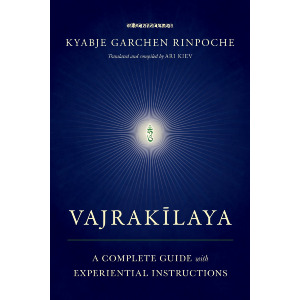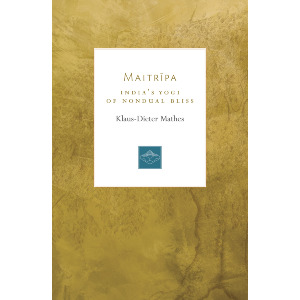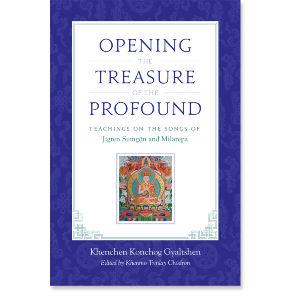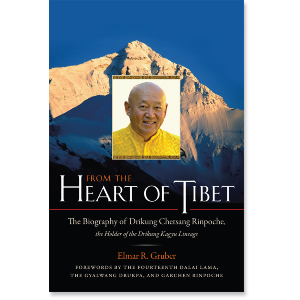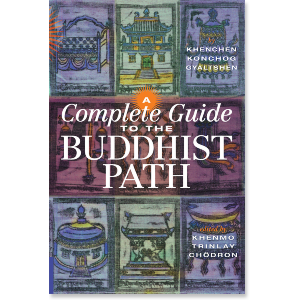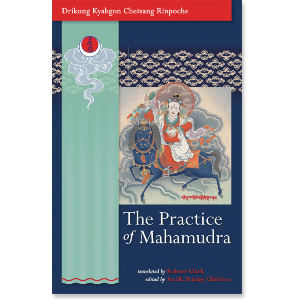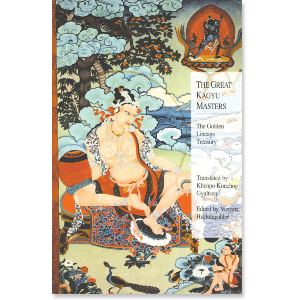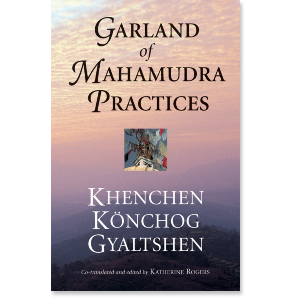| The following article is from the Winter, 1999 issue of the Snow Lion Newsletter and is for historical reference only. You can see this in context of the original newsletter here. |
The Drikung Supplication Prayer: Song of Rainfall
by Kyobpa Rinpoche, Jigten Sumgon (11431217), founder of the Drikung Kagyu lineage.
Like the turquoise dragon thundering over the Drowo Lung in the South
You translated into Tibetan teachings of the Hearing Lineage
The translator, Marpa Lolsawa remembering again and again
I pray with single-minded yearning
Please bless me, may I become like you!
In May 1999, His Holiness the Drikung Kyabgon, Chetsang Rinpochethe senior throne-holder of the Drikung Kagyu lineagewill begin his two-month North America Dharma tour. His Holiness will be giving public lectures, Refuge and Bodisattva vow transmission, Tantric empowerments, oral transmissions and instructions, transmissions and teachings of famous Drikung Kagyu traditions such as the Five-fold Profound Path of Mahamudra and the Great Drikung Phowa, and a Thousand-armed Chenrezig Drubchen in San Diego, CA. The highlight of this tour will be the conferring of the Kagyu Ngak Dzod (bka' brgyud sngags mdzod) or The Treasury of Kagyu Tantric Teachings, in Charles Town, West Virginia, May 22nd-June 7th. This important event will be sponsored by the Tibetan Meditation Center, Frederick, Maryland. The Tibetan Meditation Center, founded in 1982 by the Ven. Khenpo Konchog Gyaltsen Rinpoche, is the North American seat of the Drikung Kagyu lineage.
A Short Introduction to His Holiness the Drikung Kyabgon
His Holiness the Drikung Kyabgon Chetsang, Konchok Tenzin Kunzang Trinley Lhundrup, was born in Lhasa on the 4th day of the 6th lunar month in the Fire-dog year (1946). Annually, this corresponds to the anniversary of Lord Buddha's first turning of the Wheel of Dharma. His father, Dundul Namgyal, is from the Tsarong family. He was indisputably recognized as the Seventh Drikung Chetsang incarnate through many auspicious indications. At a young age, His Holiness left his family to take up religious life. As he recalls, I remember being taken to His Holiness the 14th Dalai Lama when I was only four and a half years old for the haircutting and naming ceremonies. Afterwards, we went to the Drikung Kagyu main monastery for the formal enthronement ceremonies. It was not long after that, in 1950, that the first Chinese Communist invasion of Tibet began. Nonetheless, the young Rinpoche was given the formal education traditional to his status.
He was taught how to read and write by His Eminence Gyabra Rinpoche, and gradually received the teachings initiations and transmissions from the general body of Kagyu lineage teachings (including the Kagyu Ngak Dzod), and from those exclusive to the Drikung Kagyu. He also began to study the major and minor sciences such as grammar, medicine, astrology and so forth with his tutor, Ven. Ayang Thubten Rinpoche. I started my philosophical studies in 1958. We began to study the 37 Practices of Bodhisattvas and Guide to the Bodhisattva's Way of Life by Shantideva and, although Chungtsang Rinpoche was five years older than I, we studied together. This is how things remained until 1959.

...don't forget your daily practice. This is most important. Empowerment is the best way to ripen our mental continuums, but daily practice is the best to achieve enlightenment.

His Holiness's grandfather, a high government official, understood that the political situation in Tibet was turning from bad to worse, and strongly urged His Holiness to leave for India. However, the monastery officials were adamant that he remain in Tibet. Sadly, his grandfather's prediction that they would regret this decision came true very quickly. Just a few months later, from the roof of Drikung Dzong, the twelve-year-old Rinpoche watched with binoculars as Chinese troops approached. Days later, the monastery was overrun.
His Holiness remained in Tibet - studying for six years in a regular school and later transferred to a work camp during the Cultural Revolution - until 1975 when an opportunity opened for him to escape and go into exile in India. He set out on foot and alone, and arrived in Kathmandu and later Dharamsala where he was reunited with his brother. He was also officially welcomed by the Tibetan government-in-exile and many Drikungpas and other Kagyupas. A week later, His Holiness' father arrived from the United States to take him to the United States where his family has relocated.
While in the United States, His Holiness received many, many requests from Drikung followers to return to India and resume his duties as head of the lineage. In October 1978, he did so. Even though he had kept his monk vows from before, he received them again from His Holiness the Dalai Lama. In 1979, His Holiness led an enormous celebration of the 800th anniversary of the founding of the Drikung Kagyu lineage, all the more moving because it seemed to mark the return of the lineage from the brink of extinction. Shortly thereafter, he went into the traditional three-year retreat. His retreat master, Kyunga Rinpoche, was very strict. He would say, When you are doing prostrations, you must do full prostrations! He never gave His Holiness any special treatment, but insisted that he do everything in the proper way.
Since then, His Holiness has continued his religious training in the various traditions of Tibetan Buddhism with many masters, irrespective of their sect. For example, Rinpoche spent three winters at a Drukpa Kagyu monastery studying their special teachings on Mahamudra, among other things. He received transmission of the Karma Kagyu's lineage of the Six Yogas of Naropa from His Holiness the 16th Karmapa, and the Drukpa Kagyu version of the same teachings from the Very Venerable Drukpa Thugse Rinpoche. He received the Nying Thig Yeshe, the highest teachings of the Nyingma tradition, and the Dam Ngak Dzod, the essential teachings of all eight lineages, from His Holiness Dilgo Khyentse Rinpoche.
In 1987, His Holiness made his first world tour to begin his teaching career. Upon his return from that tour, he started the Drikung Kagyu Institute, an education center and monastery in Dehra Dun, India. At first, he had to borrow money to start construction. With good fortune and the help of some generous friends, the institute was completed within five years. On November 16, 1992, His Holiness the Dalai Lama officially inaugurated the Institute. Because he feels that education is so important, they started classes even as construction was underway. The first class had only two students, but now there are more than 140. The first three years of the curriculum are devoted to basic education. The next five years consist mainly of Buddhist philosophical studies from the Sutra tradition, and in the sixth year students attend to the Tantric tradition.
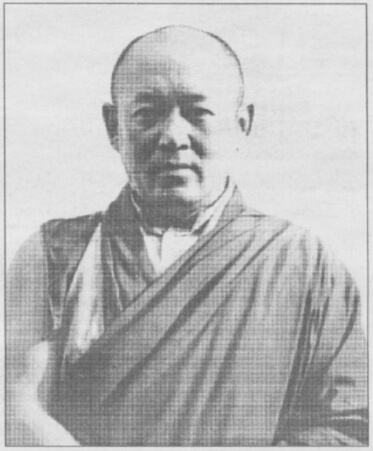
His Holiness Drikung Kyabgon Chetsang
The Drikung Kagyu has restored 60 of its monasteries in Tibet, including five nunneries. There are more than 50 monasteries in Ladakh, each with a resident lama There are also five monasteries in Nepal, and five newly constructed monasteries in different parts of India. Drikung Dharma centers and temples have been established in Germany, Estonia, Latvia, Sweden, Malaysia, Taiwan, Chile, Canada, and throughout the United States. It can truly be said that the Drikung Kagyu lineage is once again flourishing under the care and direction of its protector, His Holiness Chetsang Rinpoche.
Kagyu Ngak Dzod
The Kagyu Ngak Dzod is a compilation of esoteric teachings and empowerments transmitted by the Kagyu lineage master Marpa Lotsawa. This compilation was put together by Jamgon Kongtrul the Great (1813-1899, Jam-mgon Kong-sprul Yon-tan rgya-mtsho Blo-gros-mtha'-yas). Jamgon Kongtrul the Great was one of the great Ri-may (ris-med) masters of the late 19th century and is famous for his five collections (mdzod, treasuries). They are the Rinchen Ter Dzod (rin chen gter mdzod, collection of termas), Dam Ngak Dzod (gdams ngag mdzod, collection of the oral instructions of the Eight Lineages), Shejya Kunkhyab Dzod (shes bya kun khyab mdzod), Gyachen Ka Dzod (rgya chen bka' mdzod) and Kagyu Ngak Dzod. The Kagyu Ngak Dzod is an anthology of Tantric cycles compiled by Jamgon Kongtrul in the years 1853-1855 and is believed to be the first of his five collections. The heart of the Kagyu Ngak Dzod consists of the Seven Mandalas of Ngok transmitted by Marpa to Ngok Choku Dorje (Ngog Chos sku rdo rje), one of his four main disciples renowned for his mastery of Tantric teachings and practices. The Seven Mandalas of Ngok consists of (1) the Ninedeity Hevajra mandala, (2) the 15-deity Nairatmya mandala, (3) the 49-deity Vajrapanjara mandala, (4) the 97-deity Vajracatuhpitha mandala, (5) the 13-deity Jnanadakini mandala, (6) the Five-deity Mahamaya mandala and (7) the 53-deity Manjushrinama-sangiti. The Seven Mandalas of Ngok is prominent among the Kagyu, Jonang and Gelug schools of Tibetan Buddhism. Jamgon Kongtrul also included other important Marpa Tantric teachings such as the Chakrasamvara, Vajravarahi, Guhyasamaja, Buddhakapala, and Vajrabhairava mandalas into the Kagyu Ngak Dzod. Thus, the Kagyu Ngak Dzod brings together the oral transmissions (lung), empowerments (dbang), instructions (khrid) and ritual practices/sadhanas (cho go) of the Marpa Kagyu as transmitted by Ngok Choku Dorje and his family lineage and other lineages within Kagyu. Consequently, these teachings are treasured by all the lineages of the Marpa Kagyu tradition surviving to this daythe Karma Kagyu, Drukpa Kagyu, Taklung Kagyu, Drikung Kagyu and other lineages that do not exist independently anymore.
Structurally, the Kagyu Ngak Dzod is a collection of three groups of Tantric empowerments. The first group of empowerments is focused upon deities who are considered auspicious deities related to long-life practices and the removal of obstacles. This includes Cintamanicakra Tara, Amitayus and Vajrapani. The second consists of the major Tantric mandalas mentioned above. The final group consists of empowerments of Dharmapalas such as the Two-armed and Four-armed Mahakala, Dhumavati Devi and Tseringma. During this particular conferment of the Kagyu Ngak Dzod, His Holiness will also confer the Kalachakra empowerment at the end.
His Holiness has personally chosen to confer the Kagyu Ngak Dzod as it is the most important collections of Kagyu Tantric teachings. It is a very rare and precious event and is especially significant to all Kagyupas. His Holiness has expressed his hope that this event be fully publicized to all Tibetan Buddhists in the United States and especially all Kagyupas. His Holiness himself has expressed that he only intends to confer the Kagyu Ngak Dzod four times in his present lifetime. As such, all interested parties especially Kagyupas are encouraged to attend this historic event.
The following interview with His Holiness was given in October 1998, in relation to the upcoming conferment of the Kagyu Ngak Dzod.
Hun Y. Lye: Your Holiness, why is it important for Kagyupas to receive the Kagyu Ngak Dzod?
His Holiness the Drikung Kyabgon: First of all, Kagyu Ngak Dzod means literally, The Collection of Kagyu Tantric Teachings. It includes all of the important Tantras that were brought to Tibet by the great translator Marpa Lotsawa. Over the years, it was kept very secret. Now, for those who really want to practice Marpa's lineage of Kagyupa teachings, this is the best opportunity for them to receive the complete teachings.
HYL: Some people are apprehensive about attending all the empowerments because they feel that if they receive all the empowennents they have to do all the practices associated with these empowerments and they do not have lime to do them all. What should we say to these people to allay their fears?
HIIDK: It is not necessary to do the practice of every empowerment you have received. If it were, most of the Tibetan iamas would not have any chance to travel and teach, as they receive extensive empowerments.
The purpose of giving numerous empowennents to high lamas is to keep the whole lineage alive. Those disciples who attend these teachings must practice at least one of the Tantras given. I always recommend they practice Chakrasamvara (Demchog) as their daily practice. This is because Chakrasamvara is the most important deity in the Kagyupa lineage. This same recommendation was also made by Naropa to Marpa to be passed to all Kagyu followers. Since the nature of all deities is one, if you practice one deity yoga perfectly, you will realize them all.
As in all Highest Yoga Tantra empowerments, there are samayas, or commitments, which one must keep. They are typically very complex, but the most important one is to have devotion to your Vajra Master. If one breaks a sarnaya without knowing, by receiving empowerment and by maintaining daily practice, one will restore the commitment. This is another reason why it is important to receive empowerment and maintain daily practice.
HYL: Why should people receive these empowerments if they do not have time to do all the practices?
HHDK: As I said, disciples who attend this teaching should first be willing to maintain a daily practice of one of the simple deity yogas. If they already do a deity yoga practice, they do not need to make any changes to their daily practice. I cannot emphasize enough the importance of daily practice. Practice is the only way to experience the final result of the empowerment.
HYL: Are there any prerequisites for receiving the Kagyu Ngak Dzod?
HHDK: Firstly, they must have a strong sense of renunciation of samsaric existence. Also, they must have the correct motivation - the bodhicitta mind, the desire to benefit sentient beings. Also, they have to have a strong confidence in the lineage of the teachings as well as in the Vajra Master, the lama giving the empowerments. For intellectual preparation, I would suggest that people read Khenpo Konchog Gyaltsen's translation of The Jewel Ornament of Liberation by Gampopa and The Great Kagyu Masters, paying special attention to the life stories of Naropa, Marpa and Milarepa.
HYL: In the past, the etnpowerments in the Kagyu Ngak Dzod that are related to the Dharmapalas are usually not given to everyone, but only given to important lamas and tidkus of the lineage. Is Your Holiness giving the empowernients related to the Dharmapalas as well? Arid if so, can everyone receive it?
HHDK: The Dharmapala (Dharma protectors) empowerments, which are very rare, can be divided into outer, inner, secret and innermost. Those with the mind of renunciation, strong bodhicitta, and confidence and faith in the lineage and lama have sufficient qualifications to receive some of the outer empowerments.
The traditional reason the Dharmapala empowerments are not given publicly is to prevent them from being misused for personal gain. We should pay attention to the term, Dharma-protector. This means the protector is going to protect the person who practices the Dhanna properly, helping the practitioner to overcome obstacles. Dharma-protector does not mean personal protector or body guard. If one thinks these empowerments will make oneself more powerful, one is then mistaken. This is wrong motivation and very dangerous.
HYL: Can Your Holiness tell us something about the lineage of the Kagyu Ngak Dzod and from whom You r Holiness received the transmission?
HHDK: The great translator Marpa had four heart-sons or main Dharma disciples. The most famous of these is Milarepa. Milarepa is well-known for his practice and the ascetic life that he led in order to attain enlightenment. The other three disciples, Ngokton Choku Dorje (the Lama Ngokpa in The Life of Milarepa), Medon Tsonpo, and Tsuldon Wanga carried on the oral instmction lineage of the Tantras. These three disciples were also enlightened beings, although less famous. Kagyu Ngak Dzod is the lineage mainly passed from Marpa to Ngokton Choku Dorje.
This lineage had been kept in the Ngok family for seven generations, passed from father to son. People called this teaching, The Old Seven Mandalas of Ngok. After that, this teaching passed to the Karma Kagyu and mainly held by Drikung Kagyu. At this time, it became known as The New Seven Mandalas of Ngok.
In the 19th century, the first Jamgon Kongtrul Rinpoche discovered that this teaching had grown very weak. In order to reinvigorate the teachings, he brought the Seven Mandalas and other Marpa lineage teachings into a collection he named Kagyu Ngak Dzod. This is what we have today.
I received the transmission from His Eminence the Drikung Regent, Gyabra Tritsab Rinpoche in 1953 in Tibet. At that time I received the transmission and empowerments of the complete Drikung Kagyu and Nyingma canons over a three-month period.
HYL: Has Your Holiness conferred the Kagyu Ngak Dzod before? Have you given it before in the West?
HHDK: Subsequent to His Holiness the 16th Gyalwa Karmapa giving the Kagyu Ngak Dzod in Nepal in 1978, it has not been given in its entirety by any Kagyu throne-holder. I have always given bits and pieces of it over the years, but due to time constraints, never the entire teaching. People have continued to request frequently this teaching so now I must agree to give it. The fact that this teaching is now being given is very important. At the end of 1998 I gave it in Taiwan - the first time it has been given there. I've also been requested to give it in 1999 in America and in the year 2000 in Germany. This is the first time it has been given in those countries. I will also give it in 2001 in Dehra Dun, North India for the Drikung Kagyu Snake Year teachings there.
HYL: Can Your Holiness say something about the unique features of the Drikung Kagyu tradition?
HHDK: The Glorious Drikung was founded by Lord Jigten Sumgon, the reincarnation of Nagarjima, in 1179. It is a practice lineage, meaning that it seeks true meaning, rather that literal meaning, wisdom rather than conceptual thought, and ultimate truth rather than relative method.
As a practice lineage, retreat has been a very important feature. Traditionally, the Drikung Kagyu practitioner did at least nine years of retreat. The first three years were really about learning how to do the retreat. The second three years were then the beginning of real retreat practice. The final three years were, optimally, skillful practice.
The Drikung Kagyu also has a unique tradition of teaching and scholarship. The year was broken up into four seasons of teaching. During the summer, the Fivefold Profound path of Mahamudra was taught. The Six Yogas of Naropa were taught during the winter. During spring and fall, the Essence of Mahayana Teachings and the Gong-chik special Drikung teachings were taught. This established a foundation upon which complete knowledge of the practice and philosophy of the Three Vehicles was learned.
HYL: Does Your Holiness have any further advice for disciples who wish to attend this very important teaching of the Kagyu Ngak Dzod?
HHDK: With strong faith and the right motivationto benefit others as well as oneselfthese empowerments can purify much of our negative karma. When we request the lama to turn the wheel of Dharma and make offerings to the lama and deities, we will accumulate great merit. Then, if we can follow the visualization instructions of the Vajra Master, we will have a better chance to receive the blessing from the lineage. Finally, at the end of the empowerments we must dedicate the merits to the enlightenment of all sentient beings.
Also, don't forget your daily practice. This is most important. Empowerment is the best way to ripen our mental continuums, but daily practice is the best to achieve enlightenment.
(Article by Hun Y. Lye, a Drikung Kagyupa and a Ph.D candidate in East Asian Buddhism at the University of Virginia. The writer wishes to express his thanks and gratitude to His Holiness the Drikung Kyabgon for the precious interview and Mr. Gene Smith for his kindness and invaluable help in the preparation of this article. The section on the biography of His Holiness the Drikung Kyabgon is mostly taken from a privately published photo-biography of His Holiness - His Holiness Drikung Kyabgon Chetsang Rinpoche, edited by Ani Christine. Any mistake in this article is entirely due to the writer's inadequacies. For information on the US teachings of His Holiness, see advertisement in this issue or last.)


